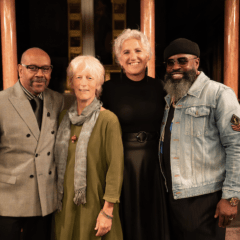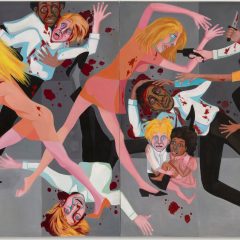I enjoyed a tsunami of memories at the newly opened Pennsylvania Academy of the Fine Arts exhibit The Female Gaze: Women Artists Making Their World. The memories were of work by so many of the artists represented in the show, work that had made me fall in love with art in the first place.
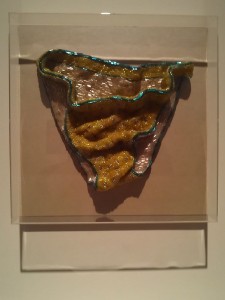
The exhibit includes 200-plus works selected from nearly 500 works of art by women donated to PAFA by Philadelphia collector Linda Lee Alter in 2010. Alter collected the works with the express ambition of donating them to an institution to make women’s art more visible.
PAFA’s acquisition of so many outstanding works by women artists who created work from the 1950s to today marks an important rebalance of the PAFA collection. I love that the Philadelphia art-collecting institution best known for its conservatism has consistently of late shown its commitment to democratizing its collection with work by minorities and women. But the scale of this particular acquisition takes the commitment to a new level. Curator Robert Cozzolino deserves credit here.
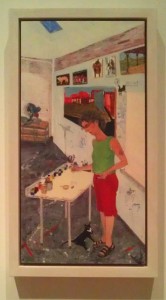
Although most of the works are 2-D and easy to fit into an urban apartment–Alter’s urban apartment–the first piece on view is an enormous Viola Frey near the foot of the great stairway in the Hamilton Building. From Edna Andrade to Alison Saar to Liza Lou, the show includes important and influential artists. Joan Brown, Jenny Holzer, Kara Walker–I could keep going. And a good showing of Philadelphia artists including Diane Burko, Anne Minich and Emily Brown are part of the exhibit. By-and-large, like most women artists no matter how worthy, they have had the experience of being under-exhibited and underpriced on the market dominated by a male-dominated matrix of taste and interests. Ooops, preaching to the choir no doubt. Sorrreee.
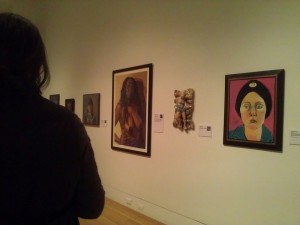
Here are some examples of items that crystallized for me what matters about the show:
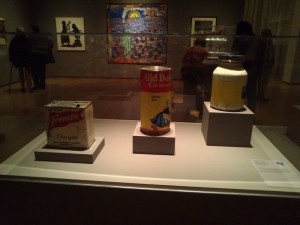
To see Karen Shapiro’s ceramic over-sized replicas of a tin of Old Dutch Cleanser and a tin of French’s ginger, representations of real and unempowered lives, is to feel a sense of wonder at how different Pop objects from a woman can be from the chill of Warhol’s Brillo boxes or from Jasper Johns’ replica of the artist’s paint brushes in a can.
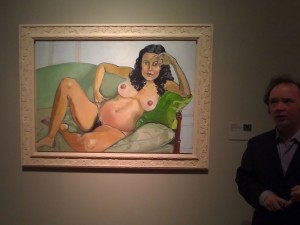
The frank gaze of the subject in Alice Neel’s Portrait of Claudia Bach, Pregnant, belongs to an anti-Olympia, with the delicate reality of delicate blue veins criss-crossing Bach’s breasts and the startling truth of pubic curls. Beverly McIver’s Mom on Oxygen, lays the artist’s heart bare, in a subject that has nothing to do with sex or power or religion.
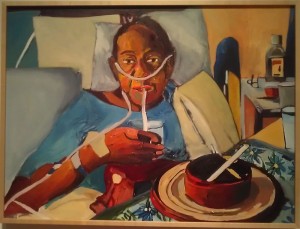
But this exhibit, which has ethnicity and race as well as gender in mind, is part of an even larger story. It is part of a long term shift–since God faded with the triptych and kings fell off their thrones–to the democratization of art.
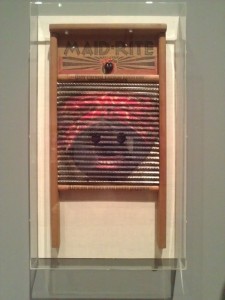
That democratization is represented here not only in who is making the art but in how. There’s a solid African-American presence in the collection as well as a smattering of other non-whites. Kara Walker is represented by her silhouette figures etched into glass cannisters. Yup! Canisters. Faith Ringgold uses needlework for a monumental history painting quilt. Betye Saar’s mixed media portrait of a maid is made with a vintage washboard, using outsider art techniques. (Speaking of democratization, some outsider artists are also in the mix).
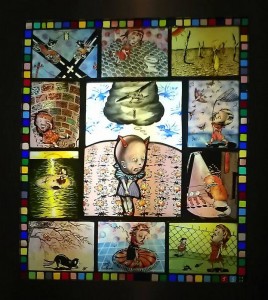
These traditional craft and vernacular materials and domestic references are also part of that democratization. The trend touches not just the African-American artists, but white ones too. Liza Lou shows sequinned panties (oh, well, with a substrate of papier mache, not fabric!) worthy of the cheering squad, and Judith Schaechter has single-handedly rejoined the craft of stained glass with fine-art and cartoon sensibilities.
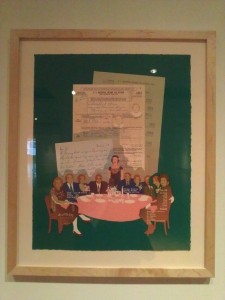
Which brings me back close to where I began–another piece about a mother. Tamarind Press founder June Wayne has a beautiful suite of prints about her mother, each image based on some of the objects from her mother’s life. The images range from garters to report cards; the biographical weight of a mind and body lost and beyond resurrection moved me to tears.
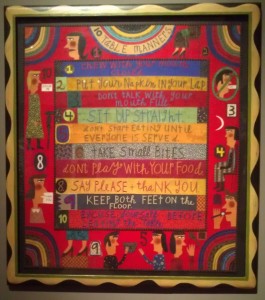
I was struck (I need to confess I really didn’t spend much time with the landscapes) by the concrete ways that women view bodies differently. The exclusion of female practicality and acceptance–neither the sentimentalized Virgin Mary nor the formalism of Whistler’s mom–is a loss to the culture, to art and to all our humanity.
This collection is one person’s passion to correct the record. My own corrections might have included Nan Goldin, Cindy Sherman and Zoe Strauss, but other than an Ana Mendieta documentary photo of one of her performance/installations, photography was not part of the exhibit. But if we take the long view, we can see this change has been coming for a long time. It still is. But if you are a woman artist whose work isn’t getting its fair share of respect, it’s really hard to keep waiting for the art world to catch up.
The Female Gaze
Pennsylvania Academy of the Fine Arts
Nov. 17, 2012 – April 7, 2013




